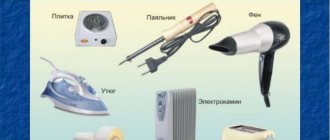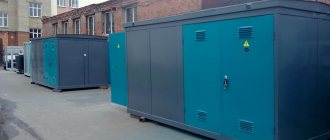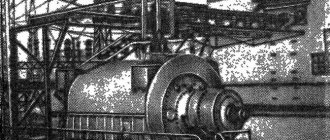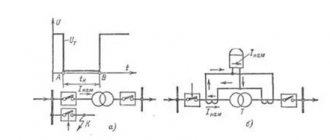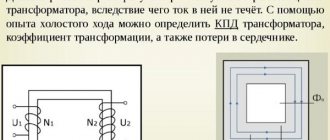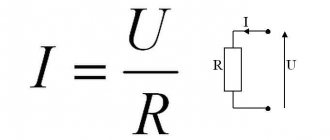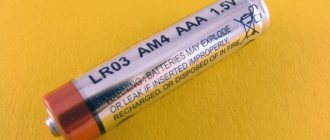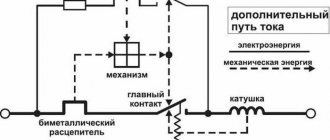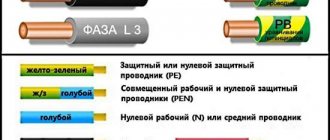The owner of the house has to master a huge amount of information that has nothing to do with his professional activities. It’s just different communication with representatives of various organizations that supply us. Very few people can explain in simple terms what happened or what they need. So you have to be aware of most of the terms they use. For example, when connecting to the mains or when there is no light, we often talk about “electric feeder”. Moreover, electricians themselves cannot always explain what it is.
What is a feeder in electrical engineering?
The name of the term comes from the English word “feeder”, which has several translation options. Of these, the closest to the energy area is the “auxiliary line,” which perfectly describes the purpose of the electrical feeder. This is perhaps the only clear definition of this term in the energy sector, since it does not appear in regulatory documents.
This situation causes some confusion even among professionals, since this term can mean both power lines from which the main substation units are powered (see Fig. 1), and lines between transformers and certain switches. Also, in some cases, cable networks and overhead lines with a voltage class of 6.0-10.0 kV fall under this concept.
Feeders in the figure are marked in red
Please note that taking into account the translation of the word “feeder”, such an expression as “feeder lines” will be perceived as a tautology, so it is better to refrain from using it.
Components
What is a feeder in electrical engineering? Since it is the main conductor, it supplies power to the main load center and then to the distributor (usually three-phase, four-wire). Next, the load enters the service network, to which direct consumers are already connected (see Figure 2).
Figure 2. Internal feeder line elements
Feeders in electrical engineering are designed based on the current-carrying capacity of the conductors, and their calculations are made based on known values of the voltage drop and line duration (maximum - up to 12...15 km).
Not all conductors are included in the line. Those of them that are located between the service point and the devices designed to disconnect the consumer are service conductors. Special maintenance rules apply here since they do not have grounding devices or other protective devices (other than those provided on the primary side of the secondary transformer).
An electrician's feeder does not always represent any internal branching, since the branched circuit includes conductors between the overcurrent device protecting the circuit and the outlet (regardless of what current the fixture is rated for).
Types and classification
Considering that this term has several definitions, it is reasonable to classify it according to the area of application, we list them:
- Radio engineering (radio feeder) . In this field, a feeder refers to the lines that carry the RF signal from the antenna device to the receiver, and also provide communication between the transmitter and the antenna. In this area you can also find the following terms:
- high frequency feeder (coaxial cable);
- feeder cable (same meaning as above);
- feeder bridge (a structure for the cable line from the antenna complex to the technical room).
- Electronics manufacturing . Sometimes the power input on CNC machines is called a feeder input. In this case, there is an incorrect translation of the technical documentation for the equipment, but this term has taken root and is often used.
- Among the fishing equipment there is feeder equipment.
- Paintball equipment . This term applies to the mechanism for feeding the balls into the marker, as well as the container in which they are placed.
- Energy . Not everything is so certain here, so
- As already described above, in the energy sector there is no clear definition of the term feeder, so classification is possible only on the basis of practical application.
Alternative terms
As mentioned above, the term “feeder” has been in use for a long time. But since this word is of English origin, it is not always and everywhere widely used. Although there are many different documentations with the designations "feeder" or "feeder cell", the word "line" is also widely used instead of the English terminology. This is facilitated by the spread of the term “feeder” in radio engineering in various antenna devices. Therefore, the term “outgoing line” is understandable as a purely electrical engineering name. But so far there is no regulatory documentation on this topic. Both words have equal meaning.
Therefore, we can call the corresponding section of the electrical circuit located between the substation buses at the input and output of the power supply system, both the feeder and the outgoing line. And in our everyday life, a feeder, in fact, is every electrical cord connected to a 220 V power outlet.
- Power lines, their characteristics and classification
- Measuring loop resistance phase - zero
- What is a single line power supply diagram and how to draw it?
Feeder at substation
Let us give a practical example that will help you understand how this term is viewed in the electric power industry. For this purpose, consider a fragment of the substation diagram given below.
Substation diagram fragment
In this example, the definition of feeder includes the entire circuit with switchgears connected to the substation cell F101, that is, sections designated on the diagram as A and B. At the same time, this term can be used to describe the line supplying power to the network of switchgears (A ). In this case, section B will be considered as feeder network 101.
If it is necessary to remove the load from a specific feeder, then the circuit breaker of a specific feeder cell is turned off. When we talk about feeder damage, this means an accident on the power line of the distribution network (section B).
On the one hand, this allows you to accurately identify a section or line, on the other hand, it introduces confusion. For example, disconnecting the feeder can be understood as disconnecting the cable from the cell and the main network switch (B), in the latter case the power supply line will remain energized. The currently practiced identification of lines by numbers eliminates such an error. As for the term “feeder”, it is used less and less.
Budget feeder forms
Fishing with this type of gear is becoming increasingly popular, so the market is overflowing with rods. Let's try to highlight the best ones in terms of price-quality ratio:
- The leading place in such a unique rating should rightfully be given to the manufacturer Mikado. His inexpensive products have always been of excellent quality. The best forms are about 3.5 meters long. He produces worse long ones, which are excessively heavy and have low sensitivity.
- The next representative of the legendary manufacturers of fishing products, distinguished in the manufacture of blanks, is Shimano. But to purchase such a fishing rod you need, at a minimum, to represent the middle class. The main material in production is carbon fiber, but recently the proportion of products made from geofiber has been increasing. Such rods are lighter in weight, while increasing sensitivity and flexibility.
- The Baltic manufacturer Salmo traditionally supplies the market with budget fishing rods under its own brand. Not having their own production, they organized the broadest cooperation, ordering components from related suppliers. At the same time, the quality of the rods from this supplier is traditionally quite decent.
- Banax Picolo feeder fishing forms, according to the manufacturer, were developed specifically for Russian conditions. All models of Banax rods are equipped with an additional insert, which allows you to change the characteristics of the rod in relation to specific fishing conditions during fishing. The material used in the production of forms of this brand is graphite, the material is light and durable.
- This list can also include products from the well-known manufacturer Daiwa. They offer a wide range of models from light to heavy professional-level fishing rods.
Feeder design
We specifically used such a table of contents for the section to show its absurdity. This decision arose after browsing thematic forums and paying attention to frequently encountered questions regarding the design and appearance of the feeder.
The fact is that in energy, and electrical engineering in particular, the term is used as a definition that allows one to identify a particular section of a circuit by its relationship to the power source. That is, in this case, asking to describe the design of the feeder, or to show what it looks like, is equivalent to asking to provide a photograph of the power consumption.
Rod equipment
When the fishing rod is selected, it’s time to equip it using the prepared elements. This requires only 4 steps:
- Assembling the rod. Connecting dismountable parts into a single structure (if a telescopic one is used, then it just needs to be unfolded).
- Installing the coil on the blank.
- After fixing the reel, it is necessary to bend the line guide bow and thread the edge of the line through all the rings to the top of the rod. After this, return the bow to its place.
- A loop is made at the end of the main line (or a swivel with a carabiner is attached) for subsequent connection to the finished feeder installation.
On average, installation takes no more than 5 minutes and after that does not require additional intervention. Exceptions are if there is a need to change the installation to another.
Application of feeders in electric power industry
The most obvious example will be traction substations that ensure the functioning of electric vehicles. Below is a simplified diagram of the organization of traction power supply.
Traction substation elements
Designations:
- A – Electric rolling stock.
- B – Rail contact network.
- C - High-voltage contact electrical network.
- D – Auxiliary line of traction power supply network.
- E – Return current feeder.
- F – Traction substation building.
To prevent overloading of the lines supplying the contact network, feeder automation is installed, which includes protective devices. In addition to the main one, the power supply circuit also provides backup protection to disconnect the line in the event of a short circuit. Most of the feeder equipment is installed at traction substations. Let us give as an example a typical block diagram of one of them.
Typical block diagram of a traction substation
Designations:
- RU-110 – distribution devices providing power supply to transformers.
- GPT1, GPT2 – Main step-down transformers.
- TSN1, TSN2 are auxiliary transformers; they are necessary to supply power to the substation equipment.
- PA1, PA2 – converting units.
- RU-3.3 is a switchgear that provides power to overhead contact line feeders.
Conclusion.
Taking into account the above information, it can be stated that this definition includes overhead and cable power lines that supply electric current to substations and main distribution nodes.
The feeder structuring system is quite convenient for identifying a specific section of the circuit (a specific feeder). But since there is no definition for this term in regulatory documents, there is a possibility of misunderstanding, which could cause an accident or accident. Therefore, it is better to adhere to the terminology adopted in regulatory documents.
It is important to study:
- Sample single-line power supply diagram
- Checking portable grounding
Line diagram
It will be required whenever a partial redesign of internal and external power connections is made. In this case, you need to know the values of the following parameters:
- Total design load.
- The maximum value of the demand coefficient.
- Current limits.
- Maximum length of external conductors.
- Characteristics of overload protection devices.
A typical electrical system may contain several types of feeders. In accordance with this, lines are designed for different types of loads - continuous, periodic, combined, external. The latter are taken into account when designing the energy supply system for individual buildings. In particularly complex cases, feeders can be composite, representing more than one voltage system, or incorporating direct current lines.
The electrical diagram of one of the sections is shown in Figure 3.
Figure 3. Electrical diagram of one of the indoor feeder blocks
Primary feeder lines are typical for power plants. The distribution node can be internal or external. Although the rules for electrical overcurrent protection vary depending on the load supplied, the limit is usually set at the end of the branch.
Basic types of installations
The purpose of the feeder is to deliver bait in large quantities, but in no case interfere with the transfer of the bite from the hook to the quivertip. For this purpose, a number of installations with tap leads have been developed that do not interfere with direct communication. Both sliding and fixed equipment are used. Every experienced angler has his favorite types of rigs that he uses more often than others: symmetrical and asymmetrical loop (for current), inline, flat (good for carp), helicopter, and so on.
For beginners just learning the basics of feeder fishing, we should recommend the simplest options:
- Direct installation. The feeder is equipped with a swivel (most often it has this design in the factory version). The main line is passed through the swivel, and the mobility of the feeder is limited by special rubber beads. Next, a swivel is attached to the main line, through which a leash with a hook is attached.
- Straight with anti-twist. Installation is similar to the previous one, but an anti-twist tube is used, and the leash is mounted through a double swivel with a carabiner. When fishing in still water, an anti-twist is not very necessary; you can get by with the direct installation mentioned above, but in the current it justifies its use.
- Paternoster. Elementary installation, most preferable when catching passive fish: it does not involve the use of swivels that coarsen the equipment. At the end of the main line we make a small loop, then we step back 15 centimeters and make another loop, large enough for the feeder to fit through. Then everything is simple: we tie a leash on the first loop, and a feeder on the second.
You can catch different types of fish on the feeder: sometimes even pike are caught on it. The features of the equipment and the nuances of installation largely depend on the type of intended trophy.
Feeder tackle
Feeder tackle is characterized by the presence of small guide rings on low holders. In addition, there is a small number of replaceable tips that signal bites and allow you to fish with feeders of different weights.
Feeder tackle is divided into classes:
- easy;
- ultra-light;
- medium (average);
- heavy;
- super heavy.
Most often, anglers use middle-class rods, which impress with their versatility. Such tackle can be adapted for any fishing conditions.
Test
The test should be directly proportional to the class of gear. For example, for the middle class, a rod test in the range of 40-80 g is ideal. For a light class, a weight of 40 g will be enough, but for a heavy class, you will need equipment weighing more than 80 g.
Note! The upper limit of the dough should not be exceeded.
Length
Feeder tackle consists of several parts. The length of the rod can be in the range of 2-4.5 m. The tip is painted in a bright palette, which allows it to be clearly seen when biting, even from a long distance.
Build
The length and class of gear affects the action. Massive rods with considerable length have an ultra-fast action. Light class gear is equipped with a soft parabolic action.
To perform hooking well, you need a rigid form. That is why most manufacturers produce gear with fast action. It is almost impossible to find a form with a slow action.
Note! Avid fishermen recommend using feeders 3.6 m long for fishing. The action should be fast.
The most popular manufacturers of feeder gum
The most common models of modern feeder shock absorbers are considered to be products from the British and Belgian corporation “Browning”. These manufacturers have long been trusted by consumers, so the cost of their goods is quite high. The feeder rubber from these companies is of good quality and meets all environmental standards.
Having carefully studied the products of these companies, experts came to the following conclusions:
- the diameter of the feeder is much thicker than its other analogues;
- Drennan products have a variety of colors, so they can be used in feeder fishing in domestic reservoirs;
- the most compact and high-quality knots are made from Drennan rubber bands;
- In terms of functionality, feeders from both manufacturers are on the same level.
Such conclusions merely reflect the personal opinions of some experts. For this reason, fishermen should buy plug rubber based on personal experience, their own preferences and financial capabilities.
Selection of gear for beginners
The best option for configuring feeder tackle for beginners would be to purchase a ready-made set. It includes all the necessary elements of bottom gear:
- feeder rod
- reel
- fishing line
- installation
- hooks
- feeders
- stand
Fishing store consultants will help a novice fisherman choose the optimal set. If this is not possible, then we independently select the elements of equipment for the medium rod. This video explains in detail how to choose a feeder for beginners:
The reel for the fishing rod is selected taking into account the fishing distance and the type of cord. The best option for beginners are models with a spool size of 3000, adapted for fishing with thin braided lines.
Many of them indicate that these are feeder coils
In the store, it is important to check its progress and the operation of the clutch. The weight of the reel should not exceed the weight of the rod
It is very important that the kit includes a spare spool. When fishing, sometimes you have to change the type of line.
Beginner feeders often ask the question: “Which is better to choose fishing line or braid?” It is optimal to buy both fishing line and braid. If you fish at a distance of more than 35 meters, then we definitely use a braided cord with a cross-section of 0.1-0.14 mm, depending on the object of fishing.
If fishing is carried out at close range, then fishing line and cord are equally suitable. When fishing in specific conditions - in sub-zero temperatures or during periods of mass accumulation of fluff on the surface of the water, a fishing line is used. Its diameter varies from 0.18 to 0.25 mm. Beginners can be offered models with a cross section of 0.23 mm. The fishing line should not have memory and not lose strength at the knots.
Feeder feeders vary in weight, volume, shape, and the material from which they are made. The main criterion for selecting feeders is the strength of the current at the fishing site. The fisherman’s task is to choose a feeder that would lie on the surface of the bottom and not be carried away by the current.
How can a novice fisherman check whether the feeder is being carried by the current or not? After casting, the feeder is installed on the stand and the behavior of the tip is observed. If it stands still, then the feeder is “caught on the bottom.” If the tip bends smoothly with the same frequency, then the feeder is carried by the current. Install a heavier one. For beginners, we can recommend bullet feeders with a plastic body:
With this model it is easy to make accurate casts even in windy weather. When reeling out the gear, the feeder quickly floats up and does not cling to bottom obstacles and grass.
Hooks and leaders are the most important elements of equipment. For catching medium-sized fish, it is optimal to use hooks No. 12-14 according to international numbering. For plant baits, hooks with a short shank length are used. For the worm, models with long forends are used. When fishing with bloodworms and maggots, preference is given to models made of thin wire. Among the manufacturers we can recommend Ovner, Dekoy, Gamakatsu.
The main criterion when choosing fishing hooks is sharpness. Remember that a sharp hook will significantly increase the number of successful hooks.
The simplest and most reliable feeder installation for beginners is a paternoster.
It literally takes one minute to knit as follows:
The length of the leash is selected depending on the strength of the current. When fishing on reservoirs without a current or with minimal water movement, leashes with a length of 20 to 40 cm are preferred. On rivers with a current, leashes with a length of 40 to 70 cm are more often used. For passive biting, leashes from 1 to 2 meters are used. The line diameter varies from 0.08 to 0.16 mm depending on the activity of the fish. The worse the bite, the thinner the leash.
Feeder fishing requires many other accessories. A novice feeder will need an extractor, a rod stand, a chair, a landing net and a cage.
